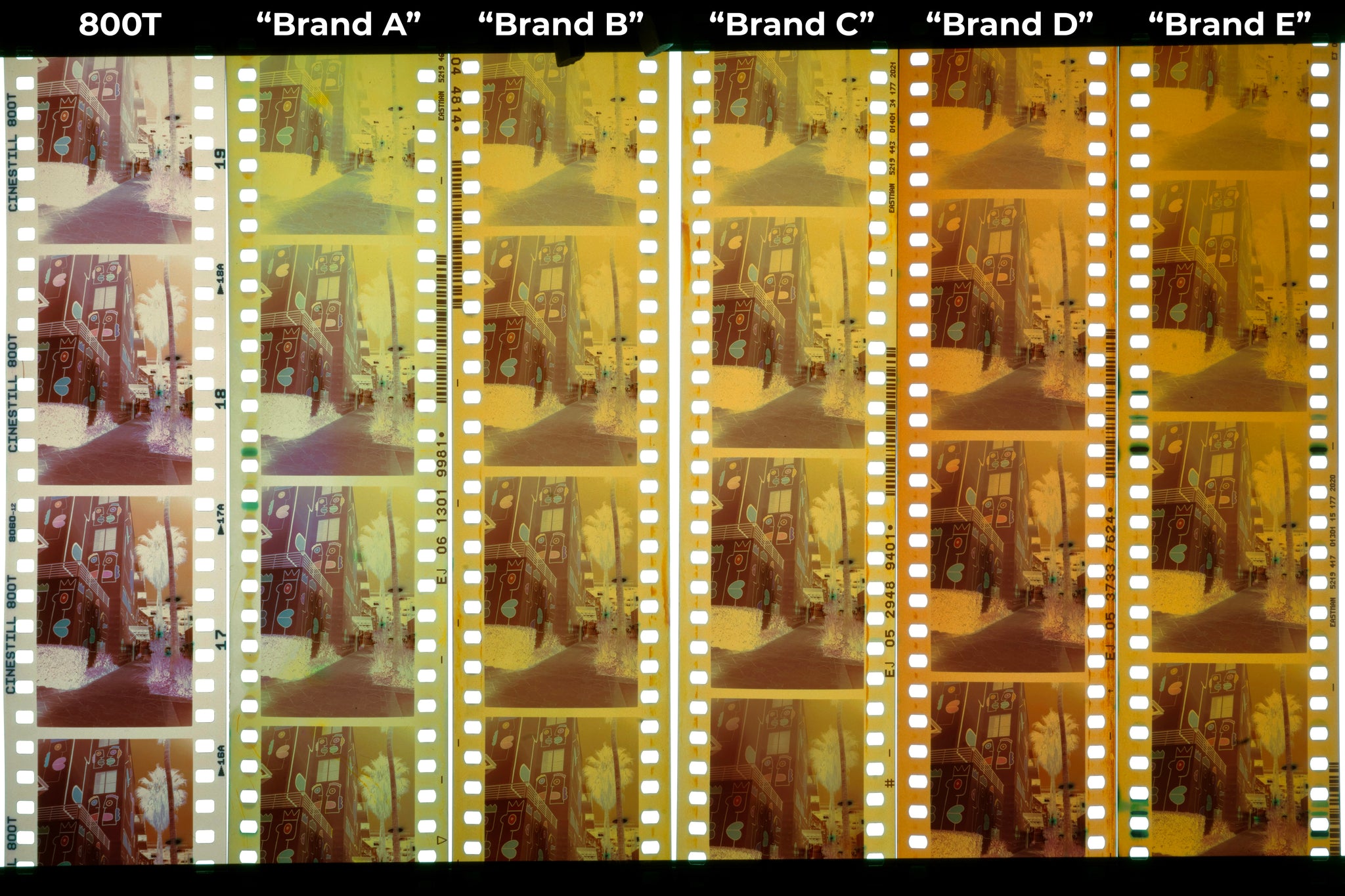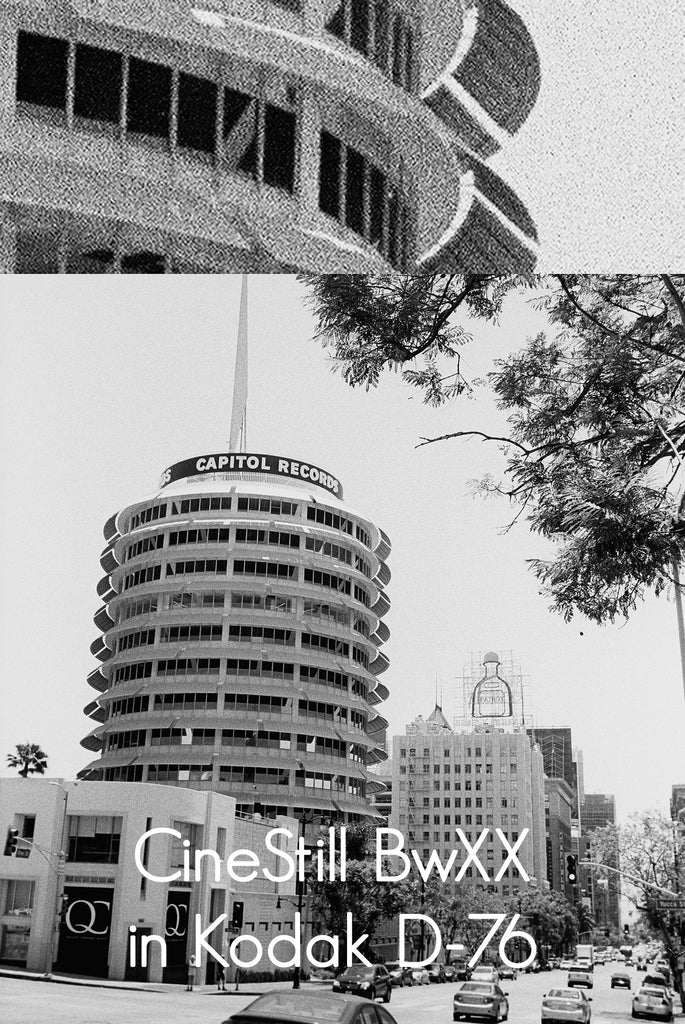News — tests
Introducing SpectraCOLOR™: Unlocking a New Era for Film Conversion
Posted by CineStill on

Developed by CineStill over the past 3 years, SpectraCOLOR™ is the next big step in closing the gap between analog beauty and digital precision. Giving you not just a “close-enough” reinterpretation, but the most accurate representation of your film to work with. Using SpectraCOLOR™-enhanced film conversion tools will ensure that you get what your film was designed for, and enjoy a simpler conversion experience.
Read more →
What Makes 800T the Original and Only True 800-Speed Tungsten-Balanced Film for Still Photography
Posted by CineStill on

When searching for CineStill films have you come across any “brand new” color films “made by” random brands lately? Are their claims strikingly similar somehow? Have they cracked the CineStill code? No, they have not… Through thorough quality assurance, we have concluded that true 800T — utilizing our meticulous and unique production process — is the only color film that can stand behind the claim of being both 800-speed and Tungsten balanced. This article will further explain how we came to this conclusion and go into detail showing the results of our extensive testing. We are not here to be nit-picky or point fingers and name names — which might get a little confusing — but some names may sound familiar to you by now. Those “800T” imitations and “400D” generics (repurposed from existing 500-speed or 250-speed motion picture film, respectively) are not representative of the original motion picture film’s quality nor the performance of CineStill films’ sensitivity and color fidelity. Although they may replicate the signature CineStill red halation glow, they are only somewhat comparable to expired film, in that they appear age fogged with shifted color-balance and exhibit a slower effective film-speed (200-400 ISO at best) resulting in a film not suitable for proposed use, let alone low-light photography; that is unless you like underexposed/expired film. For those looking for fresh film, we are fortunate to still have several other excellent high-speed color films available today (even with the recent unavailability of 400H and C200) — from UltraMax and Portra 400 to Lomo 800 and Portra 800 — but 800T is still the only tungsten-balanced, true 800-speed film made for still photography. Anything else, isn’t…
Read more →
Why the CS-Lite color modes are important for camera scanning
Posted by CineStill on
The real secret to a workable camera scan is getting a good initial capture in camera so that you don’t have to push or stretch the file more than it's bit depth or the software can handle. This means getting an appropriate exposure and color balance at the moment of capture.
With the new CS-LITE, there are 3 color modes built in: Warm for slides, White for black and white film, and Cool mode for color negatives. So for this post, we’re putting all 3 color modes to the test to show you the difference.
Raw Capture Cool | White | Warm
Cool | White | Warm
Due to the orange mask which is present when scanning color negatives, using any other scanning light source (or our CS-LITE set to the White light mode), you will need to do more than just invert the negative with added contrast and adjust color temperature further for good color, resulting in the need to use the fringes of what the sensors is capable of recording, similar to underexposing or blowing your highlights by overexposing your capture, but only in one or two color channels. RAW files are fantastic if you miss exposure a little bit, but there are limits. For example, you don’t want to underexpose your capture too much or you will see a lot of noise and contrast and color will be hard to control.
Inverted with LR Curves Cool | White | Warm
Cool | White | Warm
It needed hardly any RGB midpoint correction to adjust for the Cool setting and likely only because this was 800T in open shade, otherwise I would have been able to correct color using only white balance if it were shot on 400D or with an 85 warming filter on the lens. It is very apparent that the White and Warm light modes require quite a bit more adjustment, even when adjusting the RGB midpoints in tone curves...
Read more →
No Compromises - Cs6 3-Bath Process vs. E6 6-Bath Processing
Posted by CineStill on
With the Cs6 "Creative Slide" process the number of processing baths for E-6 film is reduced from 6 to 3. The reversal step occurs during color development in a Color&Reversal bath, and the pre-bleach, bleach steps are combined with the fixing step in a Bleaches&Fixer bath. People often wonder, "What are the compromises with combined processing baths?", such as the Cr6 "Color&Reversal" 2-In-1 Slide Solution or the Bf6 "Bleaches&Fixer" 3-In-1 Slide Solution. The reality is that there are no compromises between fresh Cs6 and carefully replenished E-6 chemistry.
Just see for yourself! We bracketed exposures of an extreme lighting situation just before sunset, with cool skylight and warm backlight. Snip tests were made and processed in each of our 1st developers at 104ºf and the remaining 2 Cs6 baths at ~85-100ºf in a Patterson tank. The remaining film was sent to The Darkroom photo lab and processed with the 6-bath E-6 process. The Darkroom specializes in professional film developing and scanning. Their Sitte Tischer TruTrak dip & dunk processor maintains high professional standards with constant process control standards. All frames were scanned on the Skier Sunray Box with a Canon 5D mk2 with all the same settings and corrections.
Kodak Ektachrome E100 with an Olympus Zuiko 50mm at f/2 bracketed 1 stop over and under.
There is a lot of conjecture and skepticism out there regarding the archival stability and efficacy of "hobby" type chemistry kits, especially when it comes to slide processing. Some rationalize that, "Professional labs must prefer the 6-bath E-6 process because it is superior." or posit, "Why then don't pro labs use combined processing baths like blix?" Well, that is not the whole story...
Read more →
Latitude for Days - D9 DynamicChrome vs. E6 Dynamic-Range
Posted by CineStill on
D9 “DynamicChrome” Warm-Tone Dynamic 1st Developer renders approximately 9+ stops of usable dynamic-range while maintaining rich warm-tones and vibrant color-contrast with preserved highlight and shadow detail (optimized for scanning) for a more cinematic look. Mixed stock solution can be measured out at 1/2 the tank capacity and diluted 1+1 with water to make a working solution for normal warm-tone development. Dilute 1+2 or 1+3 with water for further preserved highlight detail and a more neutral-tone daylight color balance.
But is extending the dynamic range of slides really possible? Of course! That's why we are so excited. When a piece of emulsion is struck by light, trace amounts of silver harden. It would take an insane amount of overexposure to reach the maximum density of the emulsion. But in order to make the hardened silver visible it needs to be amplified with a developer. If you develop it past the Dmax of the film you will lose detail. The key is to slow down development in the highlights while developing the shadows enough to be visible. While it is difficult to increase the shadow detail that is exposed below the base fog of the film, without eliminating it's beautiful inky blacks, we have harnessed the highlight latitude of slide film beyond imagination.
We bracketed exposures by 2 stops under to show how many stops of additional dynamic-range are retained in the highlights. Snip tests were made and processed in each D9 dilution at 104ºf and the remaining 2 Cs6 baths at ~85-100ºf in a Patterson tank. The remaining film was sent to The Darkroom photo lab and processed with the 6-bath E-6 process. The Darkroom specializes in professional film developing and scanning. Their Sitte Tischer TruTrak dip & dunk processor maintains high professional standards with constant process control standards. All frames were scanned on the Skier Sunray Box with a Canon 5D mk2 with all the same settings and corrections.
E-6 Dynamic-Range vs. D9 DynamicChrome
Kodak Ektachrome E100 with an Olympus Zuiko 50mm at f/8 bracketed 2 stops.
D9 DynamicChrome Dilutions Comparison
Kodak Ektachrome E100 with an Olympus Zuiko 50mm at f/8 bracketed 2 stops.
...
Read more →
No Compromises - Df96 compared with popular traditional developers
Posted by CineStill on
Due to the long history of multiple bath processes being the only ones available, many may wonder, "What are the compromises with a monobath?" Well, we can tell you that it is not compromised quality with Df96. We are standing on the shoulders of giants, and the reason monobaths weren't popular before is most likely because of economies of scale and cost, in addition to shorter shelf life. In the past, there was more profit in just producing the large volume photochemicals for film to be processed en masse. After all, back then everyone had to process film to capture a photo. Now that craft film manufacturing is being tooled for smaller batches, lower volume products can be more viable. Small batch, on demand, chemical manufacturing works just like craft beer. Fresher product with more characteristics. Thus the modern monobath was born, formulated to be produced at a craft scale.
Df96 is very forgiving for all film speeds and different emulsion types. This is partially because of the advanced developing agents used. But also as chemical development self-completes, archival fixation takes over breaking down silver and allowing physical development to redeposit it in thin areas of the film, while diffusing the grain to be finer and smoother. As you can see in the samples below, it renders somewhere between the Ilfotec DDX grain structure and Kodak Professional HC-110 tonality.
Detail crop of BwXX processed at ISO 250 in HC-110 liquid concentrate, Df96 monobath, and D-76 powder chemicals.


Detail crop of BwXX processed at ISO 250 in DD-X liquid concentrate, Df96 monobath, and ID-11 powder chemicals. 


Df96 also works well with tabular grain films, like Tmax, but to fully eliminate residual color dyes in the emulsion we double the recommended processing time. This does not affect the image since all films complete development within the first 3 minutes. Below you can see the smoothness and crisp contrast Df96 pulls out of TMax100...
Read more →
Processing 16+ different B&W films with just one chemical! Df96
Posted by CineStill on
Out of all of the available processes we've had the pleasure of using, Df96 is possibly the most uniform and consistent with all emulsions. It's not only a single-step solution, it makes over processing virtually impossible. We decided to test processing over 16 different emulsions exposed at their box speed, in one bath, at the same time, at the same temperature. Df96 has terrific uniformity due to the simultaneous development and fixing of the silver, competing to reveal every detail, from the most subtle to extreme exposure.



Df96 monobath easily processes any standard black and white film at any room temperature. It is designed with traditional cubic-grain emulsions in mind, like BwXX, TriX and HP5. It also works well with tabular grain films containing color dye technology, like Tmax, but to eliminate residual dyes in the emulsion you should double the recommended processing time. High speed films like P3200 and Delta3200 can be processed between ISO 1000-1600 by the instructions on the label, or pushed to 3200 by adding 10°F (6°C)....
Read more →
Tungsten Test Results - Portra800, 400, & 800T by Wirawan Sanjaya
Posted by CineStill on
We get asked all the time, "Why not just shoot...
